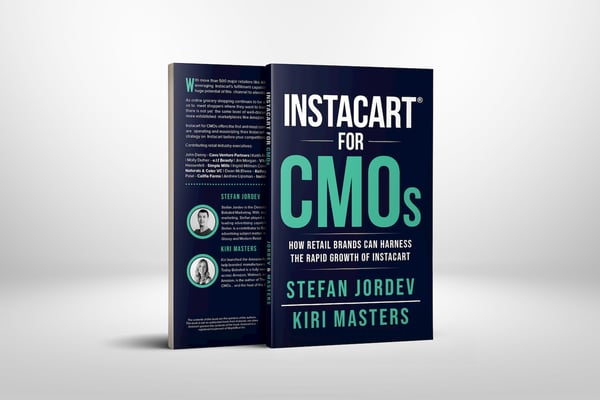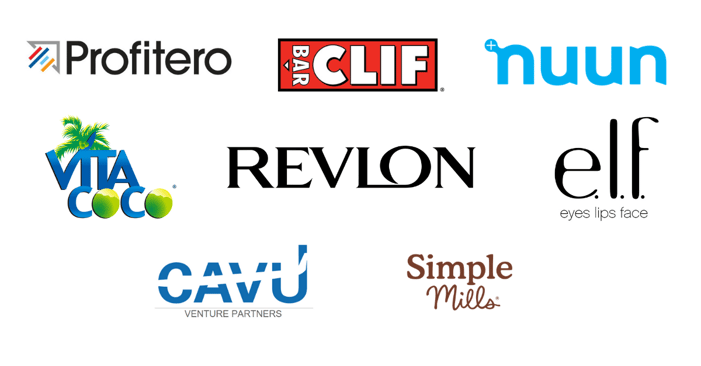After a decade of gradual growth, 2020 was truly the year that online grocery went ‘mainstream’. Quarantine and social distancing forced millions to change how they bought food and household items. A huge benefactor of this shift was Instacart, an innovative online grocery shopping platform that provides customers with unparalleled selection and convenience.
Kiri Masters – Bobsled CEO, Forbes retail contributor, and co-author of the highly acclaimed Amazon for CMOs – is bullish that Instacart’s star will continue to rise. Such is Kiri’s conviction, she, alongside Bobsled’s Director of Marketplace Strategy & Insights Stefan Jordev, have penned a book on the topic!
Instacart for CMOs is a must-read strategic resource for C-level marketing and retail executives who manage brands selling on the leading online grocery platform in North America: Instacart. In addition to Kiri and Stefan’s expert insights, the book contains contributions from leading executives who are working within this burgeoning space.


Paperback and ebook versions of Instacart for CMOs will be launching on Amazon on March 10, 2021. In anticipation of the upcoming launch, we’ve provided a chapter by chapter overview of the book below.
Read on to learn more about this rapidly ascending sales channel for grocery and CPG brands!

🎉 Instacart for CMOs is live - order now on Amazon!
Instacart for CMOs – Chapter by Chapter Overview
The following is a brief overview of what Kiri and Stefan have dug into within each section of Instacart for CMOs.
Introduction
- The Instacart origin story, and why the Amazon acquisition of Whole Foods was the beginning of big things for Instacart.
- Why unlike most other online marketplaces (Amazon, Walmart, Etsy etc), Instacart is a 4-sided marketplace (end customer, in-store inventory pickers, product advertisers and retailers).
- Where the major players (brands, retailers, Instacart itself) are heading in the context of the entire ecommerce industry.
1. The case for Instacart – now and in the future
- Digging into the demand explosion that occurred on Instacart during the Covid-19 pandemic lockdowns
- Post-Covid online grocery shopping behavior predictions and the ‘business model of data’
- Potential setbacks and challenges to Instacart’s growth
Need help understanding Instacart?
Start here – An Introduction To Instacart For Brands
2. Is investing in Instacart right for your brand?
- Explanation of why the only path to distributing products on Instacart is through a brand’s retailer partners.
- Instacart’s expansion to include non-grocery channels like 7-Eleven, Staples, SEPHORA and many others means that the channel will also impact categories such as beauty, office supplies, and pharmacy items
- Overview of how Instacart boosts brick-and-mortar sales and the ‘first-mover ‘ advantage
3. How Instacart fits among your other digital channels
- Pros and cons of Instacart in context with other digital channels
- Overview of unique advantages of Instacart e.g. you can sell alcohol on Instacart
- How brands are allocating Instacart channel management internally
 “Did you know that 20-25% of Instacart shopping activity comes from repurchasing? There's a constant validation loop of getting consumers to buy items that they already bought in the past which is incredibly beneficial for brands. Instacart’s unique ability to prompt repurchases should light a fire under the tail of brands: you must get into the customers’ basket now, as you will reap the rewards for years to come in the form of repeated purchases.”
“Did you know that 20-25% of Instacart shopping activity comes from repurchasing? There's a constant validation loop of getting consumers to buy items that they already bought in the past which is incredibly beneficial for brands. Instacart’s unique ability to prompt repurchases should light a fire under the tail of brands: you must get into the customers’ basket now, as you will reap the rewards for years to come in the form of repeated purchases.”
- Kiri Masters, co-author of Instacart for CMOs
4. Key drivers of Instacart demand generation
- Detailed insight about Instacart’s search and fulfillment algorithms
- The nuts and bolts of product listing optimization, coupons and delivery promos
- The jaw dropping data behind repeat purchases on Instacart
5. A primer on Instacart performance advertising
- The fundamentals of running paid ads on Instacart
- Insight about the fantastic ROI for early-adopter brands advertising on the channel, supported by brands reps who are currently seeing much better ad performance on Instacart vs Amazon and Walmart
- Current limitations of Instacart PPC, and what’s coming down the pike
Instacart for CMOs includes contributions by executives from the following companies:

6. Instacart’s strange relationship with a brand’s org chart and P&L
- Coming to terms with the fact that “Instacart is not a retailer or seller”, addressing the reporting and accountability challenges this creates for brands
- A breakdown of 3 typical org structure models
- Best practices about how to assemble a high functioning Instacart team
Want more Instacart advertising insight right now?
Download Bobsled’s Complete Guide to Instacart Advertising now.
7. How to measure success on Instacart
- How to acquire and analyze advertising and customer intelligence metrics
- Why reporting gets easier when your Instacart spend rises
- Halo and compounding effects in relation to world class Instacart management
8. The retailer connection
- The upsides of Instacart’s rise for brands – potential delivery cost savings, meet customers where it’s easy for them to shop
- The downsides of Instacart’s rise for brands – potentially losing more direct customer relationships, neglecting in-store shoppers, margin erosion risk
- How retailers are likely to react to Instart’s ascension, and what brands can do now to prepare
Learn more about Bobsled’s Instacart advertising management solution.
9. Your Instacart support team
- What Instacart management from an agency can looks like vs going it alone
- The software and tools that are at your disposal
- Case study from grocery brand that focused on growing Instacart channel
10. What’s next for Instacart?
- Instacart’s next moves (from Instacart themselves)
- Likely future scenarios, and how to ‘future-proof’ for each
- Comprehensive list of resources that can further inform your Instacart strategy
Tagged: Grocery & Gourmet Food, Instacart
.png)

